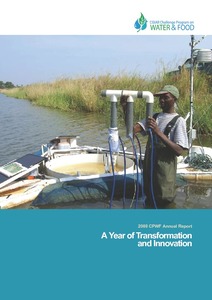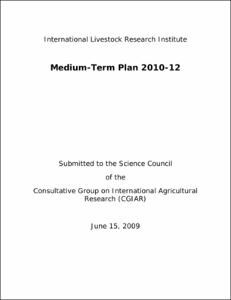CGIAR is the only worldwide partnership addressing agricultural research for development, whose work contributes to the global effort to tackle poverty, hunger and major nutrition imbalances, and environmental degradation.
It is carried out by 15 Centers, that are members of the CGIAR Consortium, in close collaboration with hundreds of partners, including national and regional research institutes, civil society organizations, academia, development organizations and the private sector.
The 15 Research Centers generate and disseminate knowledge, technologies, and policies for agricultural development through the CGIAR Research Programs. The CGIAR Fund provides reliable and predictable multi-year funding to enable research planning over the long term, resource allocation based on agreed priorities, and the timely and predictable disbursement of funds. The multi-donor trust fund finances research carried out by the Centers through the CGIAR Research Programs.
We have almost 10,000 scientists and staff in 96 countries, unparalleled research infrastructure and dynamic networks across the globe. Our collections of genetic resources are the most comprehensive in the world.
What we do
We collaborate with research and development partners to solve development problems. To fulfill our mission we:
- Identify significant global development problems that science can help solve
- Collect and organize knowledge related to these development problems
- Develop research programs to fill the knowledge gaps to solve these development problems
- Catalyze and lead putting research into practice, and policies and institutions into place, to solve these development problems
- Lead monitoring and evaluation, share the lessons we learn and best practices we discover;
- Conserve, evaluate and share genetic diversity
- Strengthen skills and knowledge in agricultural research for development around the world
Making a difference
We act in the interests of the world’s poorest and most vulnerable. Our track record spans four decades of research.
Our research accounted for US$673 million or just over 10 percent of the US$5.1 billion spent on agricultural research for development in 2010. The economic benefits run to billions of dollars. In Asia, the overall benefits of CGIAR research are estimated at US$10.8 billion a year for rice, US$2.5 billion for wheat and US$0.8 billion for maize.
It has often been cited that one dollar invested in CGIAR research results in about nine dollars in increased productivity in developing countries.
Sweeping reforms for the 21st century
Political, financial, technological and environmental changes reverberating around the globe mean that there are many opportunities to rejuvenate the shaky global food system. Developments in agricultural and environmental science, progress in government policies, and advances in our understanding of gender dynamics and nutrition open new avenues for producing more food and for making entrenched hunger and poverty history.
The sweeping reforms that brought in the CGIAR Consortium in 2010 mean we are primed to take advantage of these opportunities. We are eagerly tackling the ever more complex challenges in agricultural development. We are convinced that the science we do can make even more of a difference. To fulfill our goals we aim to secure US$1 billion in annual investments to fund the current CGIAR Research Programs.
CGIAR has embraced a new approach that brings together its strengths around the world and spurs new thinking about agricultural research for development, including innovative ways to pursue scientific work and the funding it requires. CGIAR is bringing donors together for better results and enabling scientists to focus more on the research through which they develop and deliver big ideas for big impact. As a result, CGIAR is more efficient and effective, and better positioned than ever before to meet the development challenges of the 21st century.
We are no longer the ‘Consultative Group on International Agricultural Research’. In 2008 we underwent a major transformation, to reflect this and yet retain our roots we are now known simply as CGIAR.
Members:
Resources
Displaying 9501 - 9505 of 12598CPWF Annual Report 2008
Through its innovative operations, and its facilitation of dynamic
communities of researchers, development experts, policy makers,
producers and consumers, this CGIAR Challenge Program goes
beyond research for development as usually practiced.
Yet, paradoxically for a program well-versed in technical and
social complexity, the CPWF approach is simple: to effectively
address a shared problem, we must first work together.
2008 CGIAR Annual Report."
CPWF Medium Term Plan (2010?2012)
This Medium Term Plan (MTP) is written as the CPWF transitions from its first Phase (2004?
2008) to its second Phase (2009?2013). It describes the status of the CPWF as the newly
International Livestock Research Institute: medium-term plan 2010-12
This 2010-12 MTP presents relatively few adjustments to research plans from the previous MTP. One main cross-cutting change in the ILRI research program in 2010 will be to accelerate efforts to align research activities to the livestock development challenges presented. In preparation for that, ILRI is conducting a center-commissioned external review in 2009 looking at research into sustainable intensification of smallholder crop-livestock systems to provide a review of past activities and advice on this future focal area.
Transhumance in the Tigray highlands (Ethiopia)
Transhumance, the seasonal movement of herds occurring between two points and following precise routes repeated each year, is practiced on a broad scale in the open field areas of Tigray (North Ethiopia). This article presents a characterization of the practice, factors that explain its magnitude, and recent changes. Eleven villages were selected randomly, semistructured interviews were conducted, and data on the sites were collected both in the field and from secondary sources.
Quesungual slash and mulch agroforestry system (QSMAS): Improving crop water productivity, food security and resource quality in the sub-humid tropics
The knowledge and principles generated by CPWF-PN15 confirm that QSMAS can be a model production system for implementing conservation agriculture to achieve food security and sustainable development in drought-prone areas of hillsides in the sub-humid tropics, while providing ecosystem services in the face of land degradation and climate change. As an adoptable option to replace the slash and burn traditional system, QSMAS can improve smallholder livelihoods through eco-efficient use and conservation of natural resources.






